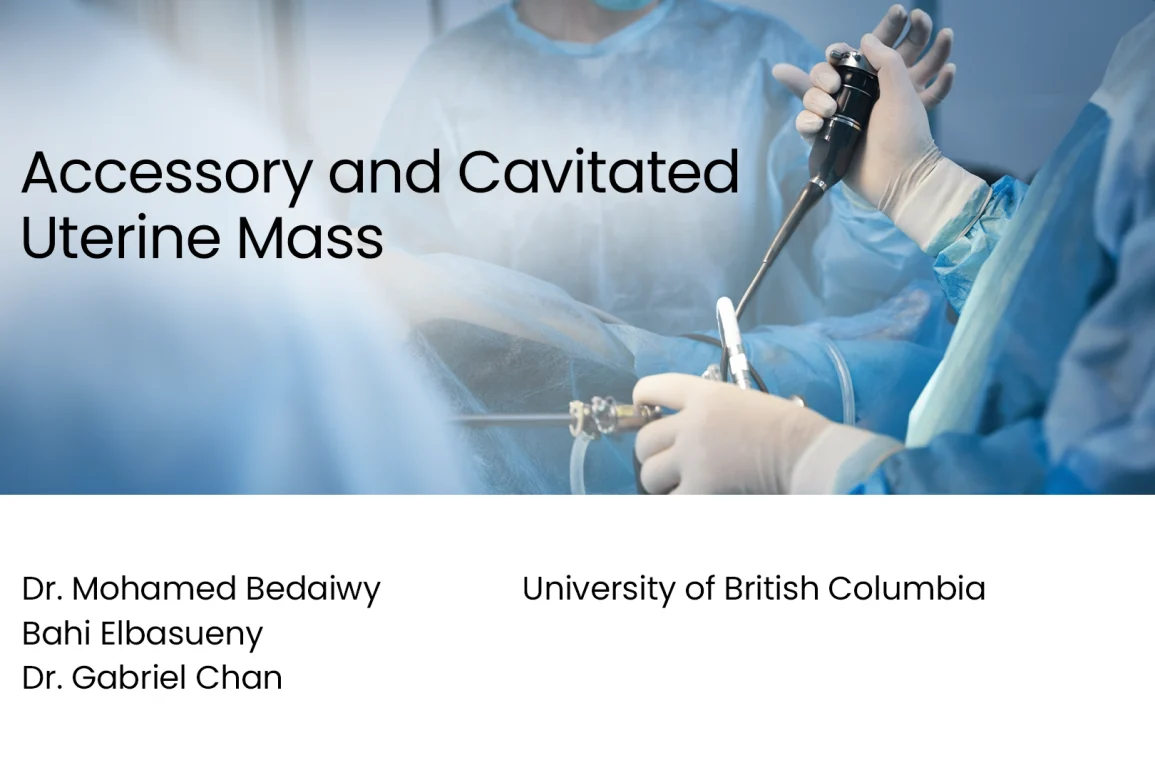Table of Contents
- Procedure Summary
- Authors
- Youtube Video
- What is an Accessory and Cavitated Uterine Mass?
- What are the Risks of Accessory and Cavitated Uterine Mass?
- Video Transcript
Video Description
Detailed laparoscopic management of bilateral ACUMs in a patient with Müllerian anomalies, highlighting diagnosis, excision technique, and fertility preservation.
Presented By
Affiliations
University of British Columbia
Watch on YouTube
Click here to watch this video on YouTube.
What is an Accessory and Cavitated Uterine Mass?
Accessory and Cavitated Uterine Mass is a rare type of Müllerian anomaly characterized by a noncommunicating, cystic mass lined by endometrium and surrounded by normal myometrium. Here’s what is important to know:
- Anatomy and Location: The mass is typically located beneath the insertion of the round ligament or near the interstitial portion of the fallopian tube, while the main uterine cavity, tubes, and ovaries remain normal.
- Pathophysiology: ACUM is thought to arise from abnormal embryologic development of the gubernaculum, which explains its consistent location near the round ligament.
- Clinical Presentation: Patients often present with severe dysmenorrhea, menorrhagia, chronic pelvic pain, or infertility that is resistant to medical management.
- Diagnosis: Imaging with ultrasound and MRI shows a well-circumscribed, cavitated lesion with hemorrhagic contents distinct from the endometrial cavity. Diagnosis can be challenging because it may mimic fibroids or a rudimentary horn.
- Management: Medical therapy has a high failure rate. Laparoscopic excision of the mass is the treatment of choice, with most patients experiencing complete or significant symptom resolution after surgery.
What are the Risks of Accessory and Cavitated Uterine Mass?
Management of ACUM, particularly surgical excision, carries several potential risks that require careful planning and technique.
- Bleeding: Vascular supply to the mass and surrounding myometrium can cause significant intraoperative hemorrhage.
- Injury to Uterine Cavity: Accidental entry into the normal endometrial cavity during excision can lead to scarring or impaired fertility.
- Adhesion Formation: Pelvic or intrauterine adhesions may develop postoperatively, potentially affecting fertility or causing chronic pain.
- Infection: Any pelvic surgery carries a risk of postoperative infection or abscess formation.
- Recurrence or Residual Mass: Incomplete excision may result in persistent symptoms or regrowth of the lesion.
- Concurrent Pathology: Endometriosis is commonly associated with ACUM and may require additional treatment during the same procedure.
Thorough imaging, intraoperative ultrasound guidance, and meticulous surgical technique help reduce these risks and improve outcomes for patients undergoing ACUM excision.
Video Transcript:
Accessory and Cavitated Uterine Mass. Accessory and Cavitated Uterine Mass, or ACUM, is a rare Müllerian anomaly. It is characterised by a cavitated lesion surrounded by myometrial mantle in continuity with the anterior lateral uterine wall. It is often located beneath the insertion of the round ligament and interstitial portion of the fallopian tubes. There is no adenomyosis, and otherwise normal endometrial cavity, tubes, and ovaries. It is rare, and the prevalence is unknown.
The main proposed pathophysiology is dysfunction during embryologic formation, specifically of the gubernaculum, because ACUMS often form near the site of the round ligament attachment to the uterus. Symptoms include dysmenorrhoea, menorrhagia, or infertility, and is often refractory to medical management.
According to a recent scoping review, there was an 85.7% rate of treatment failure with medical management alone. Surgical management in the form of laparoscopic excision has good rates of resolution, with 80% of patients report complete resolution, and the remaining 20% report partial resolution of symptoms.
Our case is a 28-year-old gravida 0 patient with moderate dysmenorrhoea and dyspareunia. She initially presented with infertility, and reported that intercourse was limited by dyspareunia. She had normal menstrual cycle, and has never had any oral contraceptives. An ultrasound was done in the community, and had the following findings.
A V-shaped uterus suggesting a bicornuate uterus, with a well-developed horn on the left, and presumed right rudimentary horn. A small, 5 mm echogenic focus in the right rudimentary horn, with likely blood products, and a hypoechoic solid structure in the right side, in keeping with a subserosal fibroid in the right aspect of the right horn.
She then had an MRI to further characterise the uterus. In the transverse view a uterine septum can be seen here. An ACUM was seen in the right uterine fundus, as shown here, and another large cystic structure can be seen on the right side. Here is the coronal view. A uterine septum can again be seen here.
An ACUM was seen again in the right uterine fundus, as shown here. And another large cystic structure can be seen on the right side. The MRI was reported as follows. A septate uterus with a thick, fibromuscular septum with no cervical involvement.
A 2.1 cm noncommunicating cystic focus within the right upper uterine body, containing haemorrhagic contents, favoured to be an ACUM, and an extrauterine cyst, with features suggestive of an endometrioma.
A cystic structure with chocolate cyst material could be seen extruding from the right uterine fundus. Both ovaries and tubes were normal. Vasopressin was injected into the base of the mass. Monopolar cautery was used to incise the uterine serosa at the base of the mass, and traction was applied, and the mass was dissected off the underlying myometrium.
The base of the mass was probed, and tactile feedback was used to determine the inferior border of the fluctuant mass. The dissection was continued along the base of the mass, and the mass was removed. Given that there were two cystic structures seen on MRI, the decision was made to perform an intraoperative vaginal ultrasound.
Here you can see in the sagittal view, a cystic mass in the right uterine body. The suction was used to identify an area of fluctuants below the previous incision. Monopolar cautery was used to incise the myometrium.
Traction was applied, tactile feedback again used to identify the mass. The cyst was entered, and chocolate cyst fluid could be seen. The mass was then dissected away from the underlying myometrium.
Use of traction and countertraction was important to visualise the dissection plane. The mass was then completely removed, and the uterine cavity was not entered. Vaginal ultrasound confirmed the absence of a cystic mass.
Here you can see the cut edges of our dissection. Uterine septum could be seen here in the transverse image. Uterus was closed in four layers with a V-Loc suture, and the serosa closed in a running baseball stitch fashion.
She had concurrent superficial endometriosis, which was excised. We then moved to hysteroscopy, where we confirmed that the endometrium had not been breached. The septum was then resected with the bipolar cautery. Both tubal ostia were seen, and the cavity was normalised at the end of the procedure.
Histology of the ACUM was negative for endometrial stroma, and the comment reports that the findings are non-specific, and may represent ACUM with denuded lining. The pelvic sidewall was positive for endometriosis. At the follow-up she reported that her dysmenorrhoea had completely resolved. She had ongoing vaginismus, and was enrolled in the multidisciplinary programme for chronic pelvic pain.
Müllerian anomalies have been reported to have varying degrees of association with endometriosis for both obstructive and nonobstructive anomalies. There have been three proposed mechanisms, including retrograde menstruation, Müllerian embryonic remnant, and metaplasia.
In conclusion, ACUM is a rare Müllerian anomaly characterised by dysmenorrhoea. Medical management is often unsuccessful. Imaging is helpful in establishing a diagnosis, and intraoperative ultrasound can be helpful to identify intrauterine lesions. Müllerian anomalies can often present concurrently with endometriosis.



